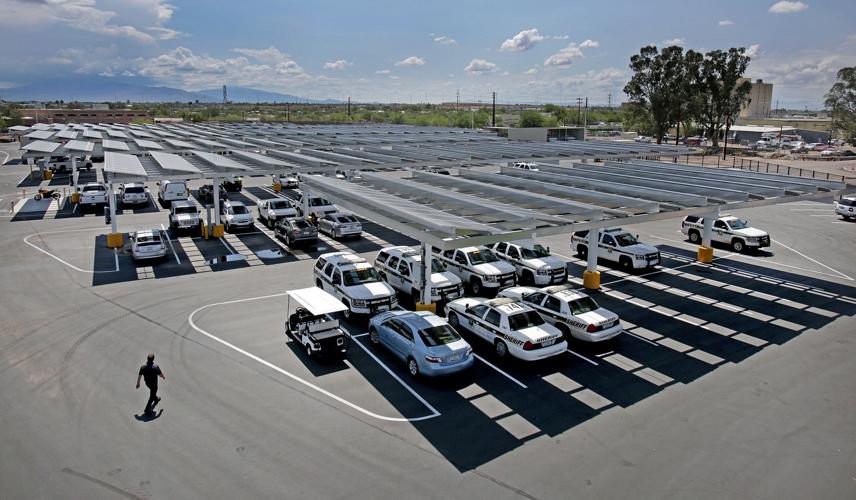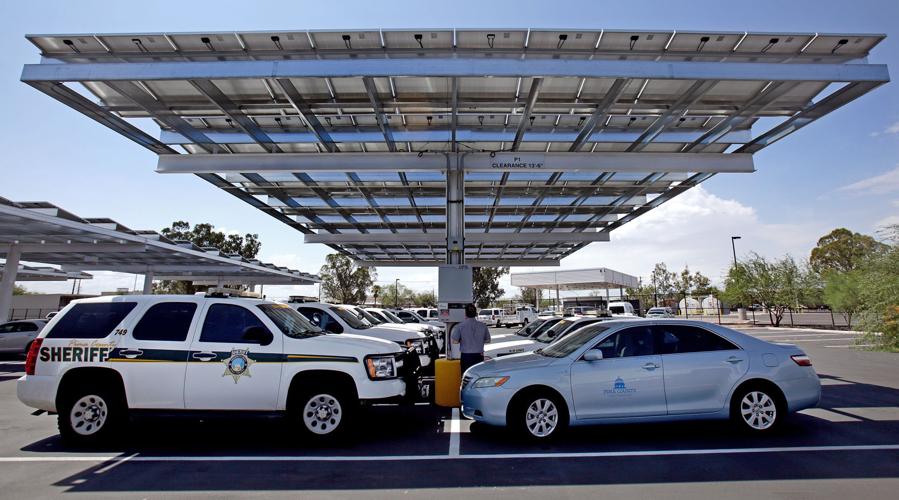More solar panels, electric cars and better-insulated buildings are key elements of an ambitious Pima County blueprint for carrying out a local piece of the Paris climate change agreement.
The county will ramp up these and other energy-saving efforts in the next few years to cut its greenhouse-gas emissions by 42 percent from current levels by 2025, officials say.
The Obama administration’s stated goal in signing on to the Paris accord was to slash U.S. emissions by 26 to 28 percent from 2005 levels by then, to hold down global temperature increases. But since the county’s emissions have risen since 2005, it needs a bigger reduction, county officials said.
The county Board of Supervisors recently approved seven such measures on a 3-2 party-line vote. The county’s action comes more than a month after President Trump said he would withdraw from the 2015 accord because he thought it was unfair to the U.S.
Specifically, the county government will:
- Buy 20 new electric-powered sedans for its vehicle fleet a year, at $30,000 to $40,000 apiece. Officials hope to start the process of soliciting bids from private companies for the first 20 vehicles sometime in the next few weeks, said Frank Samaniego, the county's fleet operations director. The county currently has two electric vehicles out of more than 1,500 vehicles.
- Increase solar and other renewable energy supplies from 21 percent of the county government’s current energy load to up to 40 percent, with a goal of installing up to 41 megawatts of such energy by next February.
- Improve energy efficiency of its 10 oldest buildings by 20 percent. This would be done, at a cost of about $4 million, by replacing older windows, improving insulation and changing employee energy use in the buildings.
- Create a downtown energy district, in which authorities would install underground pipes connecting the county’s central heating and cooling plant at 190 W. Congress St. to other downtown-area county buildings. The pipes would carry hot and chilled water that would provide more efficient and less expensive heating and air conditioning than when done for buildings individually. County officials expect the first phase of this project to be finished in a year.
- Spend $6 million to build a plant, possibly by the end of this year, to create marketable, combustible, pure methane gas. The plant would clean impurities such as carbon dioxide and hydrogen sulfide from bio-gas that’s produced from the processing of solid materials at the county’s sewage plants. The county’s Regional Wastewater Reclamation Department wants to sell the gas to Tucson Electric Power for producing energy.
- Install more “green infrastructure,” a complex concept that includes rainwater harvesting on county properties to capture stormwater and reduce flood risks. It also includes planting of native vegetation to cool building surfaces, combat the heat island effect and reduce air pollution. The goal is to increase tree cover on county properties from 7 percent today to 25 percent.
The county government’s share of regional greenhouse gas emissions is minuscule. It generated less than 0.1 percent of all emissions produced in eastern Pima County in 2014, according to the most updated regional greenhouse gas emission inventory, released this year by the Pima Association of Governments.
But the county’s action is still a good starting point, and “it’s important for government to lead,” said Ben Champion, the University of Arizona’s sustainability director. Now the county, the city of Tucson and other local governments should work together on climate issues, which will be needed to make a serious dent in regional emissions, he added.
“It’s far too much for individual efforts in isolation to get us there.”
Christy, Miller dissent
Champion was one of 10 speakers to support the county’s climate efforts when the supervisors voted to approve them on July 11.
The board’s three Democrats OK’d the climate measures, with Republicans Steve Christy and Ally Miller dissenting.
“June 2017 was the hottest June here in more than 100 years,” Christy said. “Are there guarantees — if there are, where are they? — that these steps will make the next June or June after that or 10 years from now in June less hot? I don’t see how there can be significant metrics for this.”
Urging people in the audience to read the climate pact, Miller warned that it’s “killing the economy of the U.S.”
“We can try to make ourselves believe that we are going to be better off when we have a lot of people unemployed and jobs are leaving us,” Miller said.
UA climate scientist Diana Liverman disagreed, telling the board, “We should do everything we can in Pima County to avoid the very serious risks of climate change.”
Liverman said she worked on a 2015 study on climate and poverty in Southern Arizona that found hundreds of thousands of residents must decide whether to heat and cool their homes or feed their children. “If they can’t afford to cool their homes when it’s 110 degrees, it’s going to have really serious effects on children, on their health,” she said.
Costs unknown
While the cost for all the county climate projects is unknown, County Administrator Chuck Huckelberry said the county has already budgeted for some of them. Many will ultimately more than repay their initial investment in energy savings, he said.
The county’s goal is to have them fully in place in eight years. First, “there needs to be some analysis and practical planning,” said Linda Mayro, manager of the county’s office of sustainability, conservation and historic preservation.
The city will take a step toward carrying out another local piece of the Paris accord when it seeks public comments on possible mitigation measures at its Aug. 8 City Council meeting. The night before, City Councilman Steve Kozachik will host a forum featuring representatives of the solar industry, TEP, transit advocates and homebuilders to try to generate a “community conversation” about this issue.
He said he’s looking for ideas not just for what the government can do but what people can do individually: “Things you can do in your own home, how you travel from one place to another, your own building envelope, how you weatherize.”





